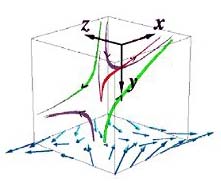First 3-D Magnetic Reconnection Measurements

Data show reconnection of two partially merging rings of plasma. The green and gray field lines represent private and reconnected field lines, respectively. The red reconnected field line crosses normal to the reconnection plane, indicating a 3-D character.
In work that promises new insights into the cosmos and fusion-energy production alike, physicists have reported they have made the first three-dimensional laboratory measurements of magnetic reconnection, the main process by which magnetic fields release energy in the universe.
Magnetic reconnection is the phenomenon in which magnetic energy in a plasma is rapidly converted to heat and jets of energetic particles. This process is thought to heat the solar corona, the outer atmosphere of the sun, to temperatures 1000 times greater than the sun’s surface itself, as well as to accelerate particles to high energies, possibly even to the very high energies of cosmic rays. Magnetic reconnection is also an important process in some experimental fusion energy reactors that use magnetic fields to confine the plasma.
The physical picture of magnetic reconnection is of two strands of magnetized plasma with oppositely directed magnetic field merging together. Until recently, this process has been studied only in two dimensions–theoretically, computationally, and experimentally.
Now, 3D experimental measurements of magnetic reconnection have been made at the Swarthmore Spheromak Experiment (SSX) at Swarthmore College. At SSX, physicists merge rings of magnetized plasma called spheromaks. Compact probes measure up to 600 magnetic field components more than a million times a second. This permits detailed studies of the ever-changing 3D magnetic structures resulting from these experiments. Measurements of the spheromaks reveal a swept and sheared magnetic structure in the reconnection region (see figure).
With SSX, researchers hope to elucidate fundamental plasma physics processes on the sun and understand new plasma structures in magnetic confinement fusion machines.
Contacts
Michael Brown (610) 328-8648, doc@swarthmore.edu, Swarthmore College
Chris Cothran (610- 690-5778, ccothra1@swarthmore.edu, Swarthmore College
Media Contact
All latest news from the category: Physics and Astronomy
This area deals with the fundamental laws and building blocks of nature and how they interact, the properties and the behavior of matter, and research into space and time and their structures.
innovations-report provides in-depth reports and articles on subjects such as astrophysics, laser technologies, nuclear, quantum, particle and solid-state physics, nanotechnologies, planetary research and findings (Mars, Venus) and developments related to the Hubble Telescope.
Newest articles

Making diamonds at ambient pressure
Scientists develop novel liquid metal alloy system to synthesize diamond under moderate conditions. Did you know that 99% of synthetic diamonds are currently produced using high-pressure and high-temperature (HPHT) methods?[2]…

Eruption of mega-magnetic star lights up nearby galaxy
Thanks to ESA satellites, an international team including UNIGE researchers has detected a giant eruption coming from a magnetar, an extremely magnetic neutron star. While ESA’s satellite INTEGRAL was observing…

Solving the riddle of the sphingolipids in coronary artery disease
Weill Cornell Medicine investigators have uncovered a way to unleash in blood vessels the protective effects of a type of fat-related molecule known as a sphingolipid, suggesting a promising new…





















